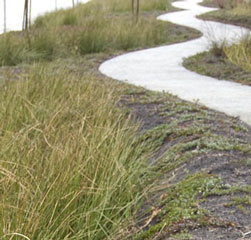
The Board of the Landscape Architecture Canada Foundation extends recognition to the many individuals and component associations who through their annual donations make these grants possible.
LIST OF 2017 GRANT RECIPIENTS AND PROJECT RESUMÉS
 DOCUMENTARIES ABOUT SELECTED CANADIAN PIONEER LANDSCAPE ARCHITECTS
Isabelle Giasson, AAPQ et Steven Turcotte
Recipient of the Gunter Schoch Bursary | Grant $4,000
DOCUMENTARIES ABOUT SELECTED CANADIAN PIONEER LANDSCAPE ARCHITECTS
Isabelle Giasson, AAPQ et Steven Turcotte
Recipient of the Gunter Schoch Bursary | Grant $4,000
Building upon their initial project, which began in 2016, this is the expansion of the documentaries from Quebec (phase 1) to include pioneers of the profession across Canada (phase 2). This will serve as a means of communication to current and future members of the profession and the general public. It will tell the tender and sensitive stories of landscape architects, their rich heritage, experiences, inherent playfulness and creative drive. The documentary will include historical photos and on-site interviews and be available via the web.
Isabelle Giasson is an experienced landscape architect with her own studio in Montreal. She has also served as a member of the Conseil d’administration of the Association des architectes paysagistes du Québec (AAPQ), of which she is currently the president. Isabelle and Steven have already selected some and compiled brief biographies of the practioners they intend on interviewing.
The LACF contribution will assist with funding of the video documentary production. It may obtain additional funding from other sources that encourage the creation of popular, innovative Canadian content and software applications for current and emerging digital platforms.
 THE CANADIAN LANDSCAPE PORTFOLIO INITIATIVE, THIRD EDITION
Jean Landry, AAPQ/FCSLA, MBA, Landscape Architect and Photographer | Grant $3,000
THE CANADIAN LANDSCAPE PORTFOLIO INITIATIVE, THIRD EDITION
Jean Landry, AAPQ/FCSLA, MBA, Landscape Architect and Photographer | Grant $3,000
The Canadian Landscape Portfolio Initiative (CLPI) is a described photographic set of collections composed of three editions that seek to illustrate Canada’s landscapes by exploring provinces and territories diversity through the eyes and written descriptions of CSLA’s member submissions. The CLPI has been designed as a participatory tool to involve as many Canadian landscape architects as possible. This phase of the CLPI is the final step leading to a descriptive and visual complement to the Canadian Landscape Charter and a presentation of why “landscapes” are so important. The Portfolio’s third edition is about transiting from a “Dreamed Landscape to Landscapes of our Dreams”, from an “abstract concept to a physical place” where people live and work…
The Canadian Landscape Portfolio third edition will take two main formats: A Web-based Portfolio to be presented and made available in the fall of 2017 plus an Ebook of selected images with their descriptive text and introductions. This edition builds upon the two previous editions completed in 2016 and 2017, with both bilingual versions to be available by spring 2017 through the CSLA web site and at www.clp-ppc.org.The first edition was about identifying personal “Significant Landscapes” and the second was about showing appreciated “Designed Landscapes”.
The LACF jury felt that it was particularly important to complete the CLPI in time for the 2017 Summit to be held in Montreal in October 2017 and look forward to its publication.
 KATERI HEALING GARDENS, KAHNAWAKE, QC;
Rick Moore, FCSLA | Grant $5,000
KATERI HEALING GARDENS, KAHNAWAKE, QC;
Rick Moore, FCSLA | Grant $5,000
Landscape architects and First Nations people have mutual respect for the natural environment. This proposal is a small step to bring our abilities and thoughts together to create the First Nations Kateri Healing Gardens.The approach goes beyond the boundaries of every day practice by exploring First Nations culture and collaborating with a recognized Kahnawake Medicine Helper and Faith Keeper on design. This collaboration will increase our cultural knowledge of plant material and of the Mohawk people. The results will be tangible, benefit the community and widely distributed.
The construction of the garden is funded by the Kateri Memorial Foundation whose ” Philosophy is one of respect for the people and the community ofKahnawake. There is an understanding of the importance of the circle of life. The Foundation’s focus is on all health-related areas with a special concern for disadvantaged groups including elders, youth and the disabled.”
Specifically, the LACF grant will help fund ethno-botanical research of culturally relevant plants for a traditional healing garden. The work includes plant selection and design as well as preparation of plant description sheets for a brochure and signage. Information will the benefits and maintenance of selected plants. It is anticipated that the garden will set a new precedent for health facilities, wellness centres and therapeutic gardens across Canada and be an important contribution to awareness of First Nations reconciliation.
 EXAMINING THE INFLUENCE OF LANDSCAPE ON THE HEALTH AND WELL-BEING OF RESIDENTS AND STAFF IN LONG-TERM CARE HOMES;
Peggy Chi, OALA, CSLA | Grant $5,000
EXAMINING THE INFLUENCE OF LANDSCAPE ON THE HEALTH AND WELL-BEING OF RESIDENTS AND STAFF IN LONG-TERM CARE HOMES;
Peggy Chi, OALA, CSLA | Grant $5,000
In 2015, Ontario announced a 10-year plan to redevelop 300 long-term care homes – almost half of the current total – thus, creating an opportunity to integrate landscape to promote health and well-being (health). This proposal seeks is to examine the relationships between the landscape characteristics and the health outcomes of residents (living with and without dementia) and nursing staff. The theory is that high quality landscape positively contributes to resident and staff health. The proposed methodology combines quantitative and qualitative approaches in two phases.
Phase 1 proposes an iterative group communication process (a Delphi panel) with experts, pilot sites, and a focus group to develop surveys for collecting data on the overall landscape characteristics of the homes and on the health of nursing staff. The developed survey for the overall landscape characteristics will assist in research site selection. In the selected homes, a collection of photographs, sketches and field notes will be quantified and analyzed to understand the spectrum of characteristics. Phase 2 entails collecting data on nursing staff’s health using the developed survey, and resident’s health using Canadian Institute for Health Information’s Metadata. This mixed-method approach will examine for significant associations between landscape and health to build onto existing literature, offer future research directions, and inform the imminent redevelopments.
The project deliverables include research findings to be communicated through two peer-reviewed publications in the Health Services Research Journal and the Health Environments Research & Design Journal, as well as presentations at conferences.
 WINTER BIKEABILITY
Erika Bullock; Master’s Candidate at University of Guelph | Grant $1,500
WINTER BIKEABILITY
Erika Bullock; Master’s Candidate at University of Guelph | Grant $1,500
The proposed course of study will explore the concept of winter bikeability and how it can be increased in Toronto with improved streetscape design. Winter bikeability criteria will be synthesized and applied to comparable study sites in Toronto, Montreal, Minneapolis, Umea Sweden and Oulu Finland. Through evaluation of these criteria for each city a set of best practices will be developed and recommended for Toronto streetscape design. It is anticipated that the results will provide direction for future planning of streetscapes in cities with cold climates and snow accumulation.
It is proposed that a paper will be published in the Journal of Transportation Research Part A: Policy and Practice, the Journal of Sustainable Cities and Society or the Journal of Landscape and Urban Planning, and presented at the 2017 IFLA/CSLA World Design Summit, if accepted.
 USING THE GEODESIGN PROCESS TO COMMUNICATE THE BENEFITS OF BIOSWALES IN URBAN STORMWATER;
Adele Pierre, Master’s candidate, University of Guelph | Grant $1,500
USING THE GEODESIGN PROCESS TO COMMUNICATE THE BENEFITS OF BIOSWALES IN URBAN STORMWATER;
Adele Pierre, Master’s candidate, University of Guelph | Grant $1,500
Bioswales can be an integral part of street design and stormwater management to, slow down clean and absorb surface runoff.
The Master’s thesis seeks to investigate the impact of using bioswales as part of the streetscape in post industrial neighbourhoods of Hamilton, Ontario and to communicate those benefits in a clear, informative and engaging manner through the use of interactive online technology. The current storm water infrastructure is aging, and with increasing storm frequency and intensity, unable to manage water runoff. The City of Hamilton, along with many cities in North America, is looking for ways of managing water on site before it enters storm sewers. Landscape architects in collaboration with other planning and design professionals create infrastructure that can slow down, clean and absorb surface runoff. GIS technology has the power to bring together many levels of information to analyze areas of impervious surface along with precipitation and infiltration rates. This information can be quantified, and various scenarios created to show the effects of altering variables. The resulting map with its many layers can be imported into an interactive online model such as ESRI CityEngine to visualize the data in 3D; a powerful means of communication for all stakeholder.
The methodology and results will also be presented in fall of 2017 to the City of Hamilton and at the ESRI Canada Conference.
HEADER IMAGE CREDIT: BLACK OAK SAVANNA, TORONTO, PHOTO: ALEXANDER BELL, SALA, CANADIAN LANDSCAPE PORTFOLIO, 1ST EDITION
For information contact
Faye Langmaid, FCSLA, MCIP Chair of the Annual Grants Program lacf.grants@gmail.comWebsite: lacf.ca
